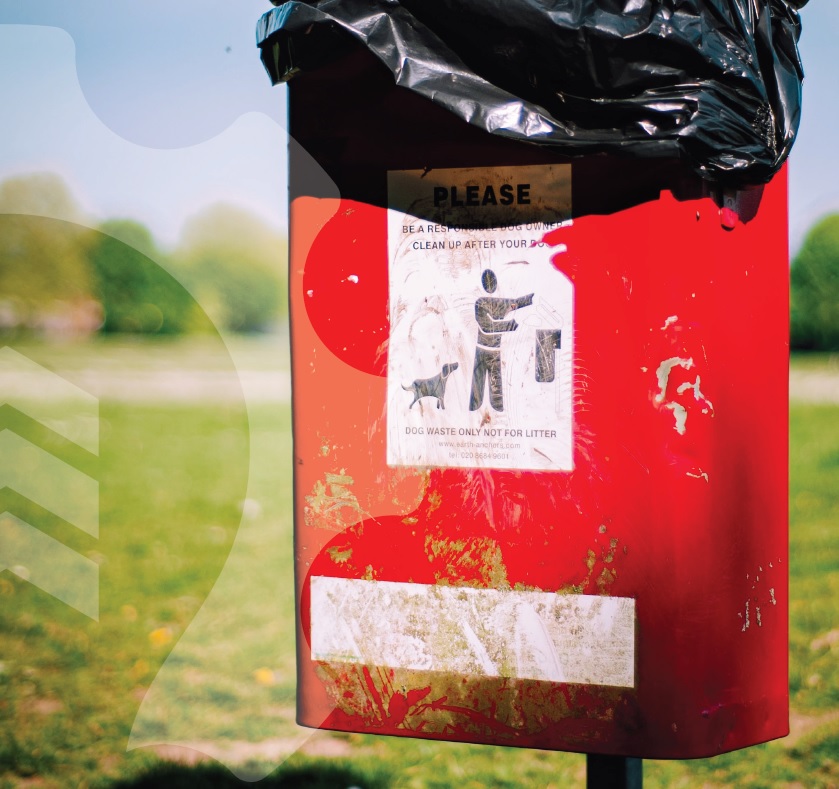
Cohort: Alpha
Organisation: Monmouthshire County Council
1. What was the overarching challenge?
Dog waste is hazardous to health and to the environment and is a significant cause of complaint to Monmouthshire County Council, yet the management and disposal of the waste has changed little in decades. The Infuse associate leading this work set out to understand whether there is an opportunity to generate energy through anaerobic digestion from this overlooked waste stream.
2. Which aspects of the challenge were addressed in the experiment (the research question/s)?
Is dog waste a viable bio-energy feedstock in a Welsh context?
3. What was done to address the challenge?
A number of work strands were put in place to tackle this broad challenge. The work is so novel that it was first necessary to better understand the potential energy benefits of dog waste. Once this was established, steps were taken to explore some regulatory barriers to its use and the use of the digestate that is created as a by-product of the anaerobic digestion process. The project also looked at pre and post treatment processes that may overcome regulatory or safety barriers to the use of dog waste.
Key actions taken as part of this exploration included a literature review. This research identified examples of similar existing or past projects utilising dog waste and gaps in existing research that needed further investigation. A regulatory review was conducted, focused on identifying regulations relating to the handling, processing and categorisation of the digestate, particularly with regard to harmful pathogens. Research laboratories that are able to test dog waste for energy values and pre or post treatments that may be required to control pathogens were also identified. The project also considered the volume and sources of dog waste that might be accessed in order to understand the scale of this energy source.
Through the process, the project has developed an understanding of the challenge, the technical issues and regulatory environment around anaerobic digestion, dog waste as a potential feedstock, and the scale of dog waste as an environmental challenge.
4. Which aspects of Infuse were most helpful in addressing the challenge?
An adaptation mindset was at the heart of this project idea. The associate leading the work was aware of the theoretical case for using dog waste as an energy source, and focused their Infuse time on building some stronger research into viability.
One tool introduced through the Adaption Lab proved to be especially useful for this project. The associate managing the project found the ‘theory of change’ tool invaluable in helping to identify the right research question to investigate within the short time available. The theory of change provided a framework for the associate to identify key inputs and resources required, and the tasks and measures necessary to achieve the desired outcome within the time allocated. The tool helped the associate break the challenge down into small, specific and achievable steps, resulting in an experiment that has produced a very strong research output, and a funding bid to further explore the issue.
5. What were the main lessons from collaborative working?
To address such a complex issue with very limited available data and resources it was vital to collaborate with other experts working in the field. Stakeholder analysis helped identify and prioritise engagement with the most relevant people. Using Infuse time, the project was able to connect with key individuals and organisations in public, commercial and academic sectors, and build relationships for further collaboration. These include Fre Energy Ltd, the AD company that was partnering with StreetKleen Ltd, the Wales Centre of Excellence for Anaerobic Digestion based at the University of South Wales, Monmouthshire County Council Environmental Health Department, Welsh Water, Usk Boarding Kennels.
6. Key findings
The experiment produced some useful findings. The topic is under-researched, and good quality data was difficult to find. The research also found that the regulatory framework in this area is complex, with different requirements set out by multiple agencies and a lack of key information relating to the topic because it is untested. However, the current regulatory framework appears to enable the use of dog waste as a feedstock, but there is a need for further clarification from the regulators, particularly in the area of controlling pathogens in the digestate.
Crucially, the experiment found that it is technically feasible to process dog waste using anaerobic digestion to produce renewable energy, although gas yield is low, but co-digestion with other organic wastes such as grass cuttings could improve gas yield and stability of the microbial community in the digester.
The experiment also found that there are opportunities to collect more dog waste, for example from kennels, vets and other professional dog services, as well as increase collection from street bins and even private households. In relation to this, the debagging of dog waste needs to be investigated in future work on the topic.
7. Next steps
Through the process of investigating the research question, three additional areas of interest have been highlighted:
· Co-digestion of dog waste with other feedstock to improve gas yield.
· Managing dog waste via existing sewerage/waste water treatment facilities.
· Pyrolysis could be an alternative energy from waste treatment process suitable for the treatment of dog waste, with Biochar as an additional environmentally positive by-product.
Funding is also being sought to further investigate the viability of dog waste as an energy source.

